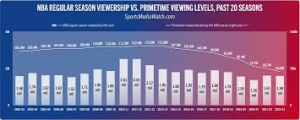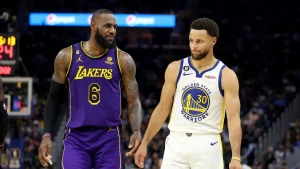The Rise and Fall of NBA Viewership A Comprehensive Analysis
The National Basketball Association (NBA) is one of the most popular professional sports leagues in the world. With star-studded teams, electrifying games, and a global fan base, the NBA has captured the hearts of millions of people across the globe. However, in recent years, there has been a decline in the viewership numbers of this once-dominant league.
In this article, we will take an in-depth look at the NBA viewership statistics and analyze the factors that have contributed to its rise and fall in popularity. We will also examine the impact of new media and technology on the league’s viewership and discuss potential strategies for the NBA to regain its lost viewership. So let’s dive into the numbers and find out what’s going on with the NBA.
1. The Evolution of NBA Viewership

The Evolution of NBA Viewership
The NBA has come a long way since its inception in 1946. From humble beginnings as a small league with just 11 teams, the NBA has grown into a multi-billion dollar industry with 30 teams and a global reach. The league has seen several changes over the years, from rule changes to expansion teams, but perhaps the most significant evolution has been in its viewership numbers.
The Early Years
During the early years of the NBA, the league struggled to gain traction and attract fans. In the 1950s, the average attendance per game was only around 3,500, and the games were not even televised. This lack of exposure and limited audience contributed to the low viewership numbers of the league.
However, things started to change in the 1960s when the NBA began airing games on national television. This increased visibility helped the league gain more fans and subsequently led to a rise in viewership. By the end of the decade, the average attendance per game had doubled, and the NBA was beginning to establish itself as a major sports league.
The Michael Jordan Era
The 1980s and 1990s saw a significant increase in the NBA’s popularity, thanks to the emergence of one of the greatest players of all time – Michael Jordan. Jordan’s flashy playing style, charisma, and six NBA championships with the Chicago Bulls helped propel the league to new heights. The NBA was now a global phenomenon, and its viewership numbers were soaring.
During this era, the NBA also started to focus on marketing and branding, which further helped in attracting fans. The league signed lucrative deals with major television networks, and the introduction of cable TV helped expand its reach even more. In the 1990s, the average attendance per game reached an all-time high of over 17,000, and the NBA was enjoying record-breaking viewership numbers.
Today’s Landscape
In the early 2000s, the NBA faced some challenges with a decline in viewership due to labor disputes and a lack of star power after Jordan’s retirement. However, the league bounced back and experienced a resurgence in popularity in the 2010s with the rise of superstars like LeBron James, Stephen Curry, and Kevin Durant.
Today, the NBA has a massive global following, and its games are broadcasted in over 215 countries. With the advent of new media and technology, the league has also expanded its reach to online platforms, including social media and streaming services. However, despite its global reach and popularity, the NBA has seen a decline in its viewership numbers in recent years.
2. Factors Affecting NBA Viewership

2. Factors Affecting NBA Viewership
There are several factors that have contributed to the rise and fall of NBA viewership over the years. Let’s take a closer look at some of these factors and their impact on the league’s viewership.
Star Power
The NBA has always been a star-driven league, and the presence of superstars has a significant impact on its viewership numbers. As we saw in the Michael Jordan era, having a dominant player or a group of stars can significantly boost the league’s popularity and attract more fans.
In recent years, the increase in player movement and the formation of superteams have helped create buzz among fans and media. However, this has also led to a lack of balance in the league, with only a few teams dominating and others struggling to compete. This imbalance can potentially lead to a decrease in viewership, as fans may not be as invested in the outcome of games.
Competition from Other Leagues
Another factor that has affected NBA viewership is the rise of other professional sports leagues in the United States, such as the National Football League (NFL) and Major League Baseball (MLB). These leagues have a loyal fan base and often compete for viewership with the NBA during their respective seasons.
Moreover, the emergence of new sports leagues, such as the Premier Lacrosse League and the XFL, has also created more competition for the NBA. With so many options available, fans may choose to follow other leagues instead of the NBA, leading to a decline in viewership.
Shifting Viewing Habits
With advancements in technology and the rise of new media, the way people consume content has changed drastically. Today, fans have more options than ever before when it comes to watching sports. From traditional television broadcasts to online streaming services, the viewing habits of audiences have shifted significantly.
This change has affected the NBA in two ways. On one hand, the league has expanded its reach through various platforms, including social media and streaming services. However, on the other hand, the decline in traditional TV viewership has impacted the league’s overall numbers. With more and more people cutting the cord and opting for streaming services, the NBA has had to adapt to this changing landscape.
3. The Impact of New Media and Technology on NBA Viewership
As mentioned earlier, the emergence of new media and technology has played a significant role in shaping the NBA’s viewership numbers. In this section, we will explore the impact of these factors on the league’s popularity and discuss their potential implications for the future.
Social Media
Social media platforms, such as Twitter, Facebook, and Instagram, have become an integral part of the sports world. These platforms provide an avenue for fans to engage with their favorite teams and players, creating a more personal connection. The NBA has embraced social media, and its players are among the most active and followed athletes on these platforms.
Furthermore, social media has also helped the NBA expand its reach globally. With millions of followers from all over the world, the league can connect with fans from different countries and cultures, increasing its popularity. This has also opened up new revenue streams for the league, as it can now market its products and services to a larger audience.
Streaming Services
The rise of streaming services, such as Netflix, Hulu, and Amazon Prime, has disrupted the traditional television model, and sports leagues, including the NBA, have had to adapt. In recent years, the NBA has partnered with various streaming services to offer live games and highlights to fans who prefer to consume content online.
Moreover, the NBA has also launched its own streaming service, NBA League Pass, which allows fans to watch games live or on-demand. This has not only increased the league’s reach but also provided an additional source of revenue. However, the availability of streaming services has also led to a decline in traditional TV viewership, which has affected the overall viewership numbers of the NBA.
4. Strategies to Regain NBA Viewership

Strategies to Regain NBA Viewership
With the decline in viewership numbers, the NBA has been looking for ways to regain its lost audience and attract new fans. Here are some strategies that the league can adopt to increase its viewership.
Improve the On-Court Product
One of the primary reasons for the decline in viewership is the decreasing quality of play on the court. As mentioned earlier, the lack of balance in the league has made it less interesting for fans to watch, as only a few teams dominate while others struggle. To counter this, the NBA should look into ways to improve competition among teams, which will make games more exciting and attract more viewers.
Additionally, the NBA should also focus on improving player safety and reducing the number of injuries. In recent years, there has been a growing concern about players’ health due to the grueling schedule and the high-intensity nature of the game. By addressing these issues, the NBA can ensure that players remain healthy and provide consistently high-quality performances, which will ultimately lead to an increase in viewership.
Explore New Markets
While the NBA already has a global reach, there are still untapped markets that the league can explore to attract new viewers. For instance, countries like India and China have a huge population and are basketball-crazy nations. By investing in these markets and promoting the game, the NBA can expand its fan base and potentially increase its viewership numbers.
Moreover, the NBA can also consider expanding the league and adding new teams. This will not only create more competition but also open up new geographical areas for the league to enter. With the success of the NBA’s G-League, there is a potential for growth in the coming years, and the addition of new teams could help the league increase its viewership.
Embrace New Technologies
As technology continues to advance, the NBA must keep up with the trends and embrace new technologies to engage with fans. Augmented and virtual reality, for example, hold great potential for enhancing the viewing experience for fans. The NBA has already experimented with these technologies, and we can expect to see more of them in the future.
The league can also look into creating more interactive experiences for fans, such as live streaming of games with real-time commentary and analysis. This will not only keep fans engaged but also provide additional revenue opportunities for the NBA.
5. The Impact of COVID-19 on NBA Viewership
No discussion about the NBA’s viewership would be complete without addressing the impact of the ongoing COVID-19 pandemic. The outbreak of the virus disrupted the entire sports world, and the NBA was no exception. With the suspension of games and the implementation of strict health protocols, the league faced several challenges, including a decline in viewership.
The NBA had to adjust to the new reality of playing games in a bubble without fans, which affected the viewing experience for many. Additionally, due to the global economic downturn caused by the pandemic, some people may have cut back on their cable and streaming subscriptions, leading to a decrease in TV viewership numbers.
However, despite these challenges, the NBA managed to complete its season and crown a champion, which helped to mitigate the impact on its viewership numbers. Moreover, with the vaccination efforts currently underway, there is hope that things will return to normal soon, and the NBA can continue its upward trend in popularity.
6. The Future of NBA Viewership

The Future of NBA Viewership
As we have seen, the viewership numbers of the NBA have fluctuated over the years, and there have been many factors at play. However, one thing is certain – the NBA remains one of the most popular professional sports leagues in the world, and it continues to attract millions of fans globally. With new media and technology transforming the way we consume content, the NBA must adapt and find ways to engage with fans to maintain its viewership numbers.
The league must also focus on creating a more balanced playing field and investing in new markets to attract new viewers. Additionally, it must also continue to embrace new technologies to enhance the viewing experience for fans. With its global reach and strong brand, the NBA has the potential to bounce back and regain its lost viewership in the coming years.
In conclusion, the NBA viewership statistics paint a complex picture of a league that has seen its fair share of ups and downs over the years. From humble beginnings to becoming a global phenomenon, the NBA has come a long way, and its viewership numbers have been a reflection of its evolution. However, with changing viewing habits and increasing competition, the league will face many challenges in maintaining its popularity. By exploring new markets, embracing new technologies, and improving the on-court product, the NBA can continue to be a leading sports league and attract millions of viewers worldwide.
Strategies to Increase NBA Viewership
In recent years, the NBA has faced challenges in maintaining its viewership numbers, prompting the league to explore new strategies to attract more fans. From improving the on-court product to embracing new technologies, there are several approaches the NBA can take to increase its viewership and engage with a broader audience.
1. Enhancing the On-Court Product
Balanced Competition
One of the key factors that contribute to a decline in viewership is the lack of balance in the league, with only a few dominant teams monopolizing the competition. To address this issue, the NBA could consider implementing measures to promote more competitive parity among teams. This could involve revenue-sharing mechanisms, draft lottery reforms, or salary cap adjustments to level the playing field and make games more exciting for fans.
Rule Changes
Introducing rule changes to enhance the flow and excitement of the game could also help attract more viewers. For example, the NBA could explore ways to reduce downtime during games, such as implementing a shot clock after offensive rebounds or limiting the number of timeouts teams can call in the final minutes of a game. These changes can create a more fast-paced and engaging experience for fans, ultimately driving up viewership numbers.
Player Health and Safety
Addressing concerns about player health and safety is essential to ensuring a high-quality on-court product. By reducing the number of back-to-back games, shortening the regular season, or incorporating more rest days into the schedule, the NBA can help prevent injuries and ensure that players are performing at their best. A healthier and more competitive league is likely to attract more fans and increase viewership in the long run.
2. Expanding Into New Markets
International Expansion
The NBA has a global fan base, but there are still opportunities for growth in untapped markets around the world. Expanding into countries like India, China, or Brazil, where basketball is rapidly gaining popularity, can help the league attract new viewers and diversify its audience. Hosting preseason games, establishing marketing partnerships, or creating local outreach programs are effective ways to connect with international fans and increase viewership.
Digital Platforms
In addition to traditional television broadcasts, the NBA can leverage digital platforms to reach a wider audience. Partnering with streaming services, social media companies, or online gaming platforms can extend the league’s reach and engage with younger demographics who consume content digitally. By providing exclusive behind-the-scenes access, interactive experiences, or tailored content for online audiences, the NBA can increase its viewership numbers and stay relevant in the digital age.
Women’s Market
Another potential growth area for the NBA is tapping into the women’s market by promoting women’s basketball and supporting female fans. By showcasing women’s games, featuring female athletes, or launching initiatives to empower women in sports, the league can attract a more diverse and inclusive fan base. Engaging with women through targeted marketing campaigns, community events, and merchandise offerings can help the NBA expand its viewership and build long-term connections with female fans.
3. Leveraging New Technologies

3. Leveraging New Technologies
Virtual Reality
Virtual reality (VR) technology offers immersive ways for fans to experience NBA games and connect with their favorite teams. By providing VR live streams, virtual courtside seats, or interactive viewing options, the league can offer fans a unique and engaging way to enjoy basketball games from anywhere in the world. Embracing VR not only enhances the viewing experience but also attracts tech-savvy audiences who seek innovative entertainment options.
Augmented Reality
Augmented reality (AR) features can bring a new dimension to how fans interact with NBA content and players. Through AR applications, fans can access real-time stats, player highlights, or interactive overlays during games, enhancing their overall viewing experience. By integrating AR elements into broadcasts, social media platforms, or mobile apps, the NBA can captivate audiences and create more personalized and shareable moments that drive engagement and viewership.
Social Media Engagement
Social media platforms have become powerful tools for sports leagues to engage with fans and amplify their reach. The NBA can leverage social media channels like Instagram, Twitter, or TikTok to share highlights, behind-the-scenes footage, player interviews, and interactive polls that spark conversations and build a sense of community among followers. By creating shareable content, partnering with influencers, or launching viral marketing campaigns, the league can increase its online presence and attract a larger audience of digital-savvy fans.
4. Enhancing Fan Experience
In-Stadium Technology
Improving the fan experience within stadiums can have a positive impact on viewership both in-person and on screens. Implementing advanced technologies such as high-definition video boards, in-seat ordering systems, or interactive fan apps can enhance the overall game-day experience for attendees. By creating a more immersive and convenient environment for fans, the NBA can increase attendance rates, foster loyalty among supporters, and generate buzz that translates into higher viewership for televised games.
Community Outreach
Building connections with local communities and grassroots basketball programs can help the NBA expand its fan base and cultivate future viewers. Initiatives such as youth basketball clinics, school partnerships, or charitable events not only promote the sport at the grassroots level but also create opportunities for fans to engage with players and teams in meaningful ways. By investing in community outreach efforts, the NBA can foster a sense of belonging among fans, drive interest in the sport, and ultimately boost viewership across diverse demographics.
Personalized Content
Tailoring content and experiences to meet the preferences of individual fans can create a more personalized and engaging relationship between the NBA and its audience. Leveraging data analytics, artificial intelligence, or recommendation algorithms, the league can deliver customized content such as targeted promotions, curated playlists, or interactive quizzes that resonate with each fan’s interests. By offering personalized experiences across digital platforms, email newsletters, or fan loyalty programs, the NBA can deepen fan engagement, increase brand loyalty, and ultimately grow its viewership base.
Conclusion
In conclusion, the NBA’s quest to increase viewership involves a multifaceted approach that combines enhancing the on-court product, expanding into new markets, leveraging new technologies, and enhancing the fan experience. By addressing issues related to competitive balance, player safety, and digital engagement, the league can attract a wider and more diverse audience of basketball fans.
Furthermore, by exploring international markets, embracing virtual and augmented reality, and fostering community engagement, the NBA can position itself for long-term growth and success in an increasingly competitive sports entertainment landscape. As the league continues to innovate and adapt to changing consumer preferences, it has the opportunity to secure its place as a global leader in sports media and entertainment, captivating millions of fans worldwide through compelling content and unforgettable experiences on and off the court.













Post Comment